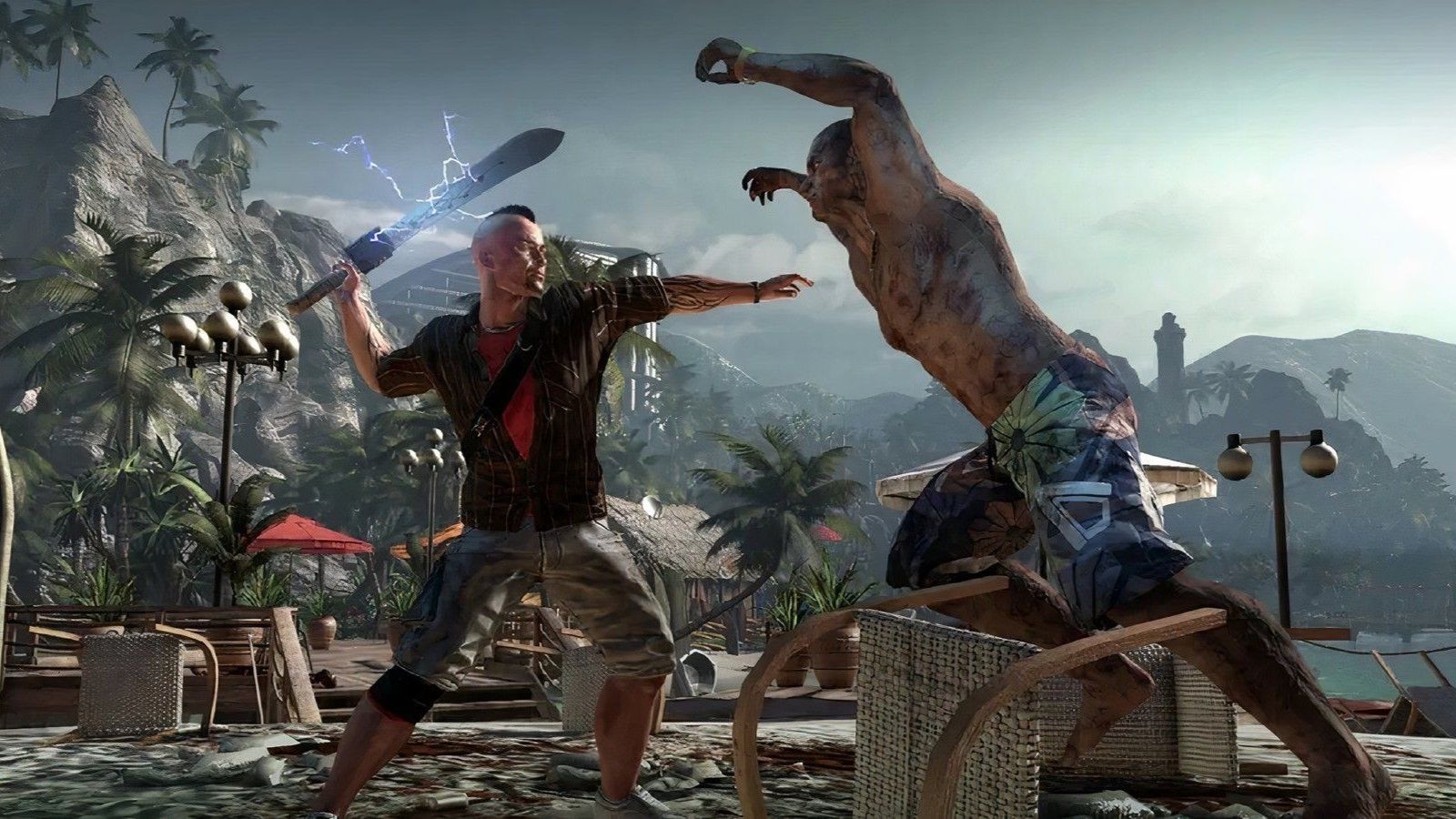Key Takeaways
- NeverDead has a unique mechanic of immortality but suffers from clunky combat.
- Fracture allows players to deform terrain, creating new tactics in gameplay.
- Dead Island features analog combat for dynamic zombie encounters.
Not every bad game ever made is bereft of good qualities or features. Sometimes, there’s that one mechanic or idea present that, had the rest of the game managed to live up to the same quality, could have resulted in a much better game. The word ‘could’ does a lot of heavy lifting in that sentence, but still.
In the pursuit of those diamond ideas hidden in the rough, let’s look at ten bad video games from gaming history with one great idea.
10 NeverDead – “Immortality”
Heads Will Roll
You’d think being an immortal would make life easy for a guy like Bryce, but the guy’s been hunting demons for 500 years and he’s kind of sick of it at this point. Fast-forward to modern times, and it’s up to Bryce to save the city from destruction thanks to a demonic invasion. So far, so standard.
What makes NeverDead a much more interesting proposition is how the game implements Bryce’s immortality. Instead of a health bar, Bryce’s body comes apart like a Ken doll being ravaged by a naughty child. Your limbs and torso go flying, with you then controlling Bryce’s head, piecing his body together like a macabre version of Super Monkey Ball.
It’s a unique game mechanic with its own charm, let down by the clunky gun play and general combat.
If you’re curious about NeverDead yourself, the prices of the physical copies these days might convince you otherwise.
9 Fracture – Terrain Deformation
Groundbreaking
By the launch of the Xbox 360, there had been a number of games that tried to experiment with environmental destruction, with Red Faction allowing players to blow holes through walls to create new attack angles. Fracture attempted something similar, only instead of carving through walls, it allowed players to shape the ground beneath their feet.

Related
10 Xbox 360 Games That Were Held Back By The Hardware
Some Xbox 360 games were good, but could have been great if only they hadn’t been held back by the hardware.
Taking place on an unstable Earth wrecked by climate change, Fracture gives players the ability to use weapons to deform the very terrain, using it to create cover, sweep the rug from underneath your enemies or form spires to reach a higher vantage point. Giving players the tools to change the battlefield is neat in concept, but it’s ultimately a gimmick that can’t quite save a generic third-person shooter.
8 Inversion – Gravity Manipulation
Flip Reverse It
Anyone who was gaming in the Xbox 360 era will no doubt remember the sheer tidal wave of third-person cover-based shooters that sprung up following the success of Gears of War, leading to waist-high walls in almost every shooter you could think of. On the surface, Inversion did little to distinguish itself from those imitators, though it did boast one key mechanic in the form of gravity manipulation.
Playing as officers of Vanguard City as it’s attacked by seemingly subterranean mutants (furthering the Gears of War comparisons), players are given control of the Gravlink, which allows you to disobey the laws of gravity. The concept of messing with gravity is a cool addition to the tried and true cover shooter formula, but it was one innovation in a sea of borrowed ideas.
7 Juiced – Career Mode
Living Life A Quarter Mile At A Time
As soon as the Need For Speed series channeled its inner Jamiroquai by heading (deeper) Underground, a few games tried to ape the urban street racing idea to varying levels of success. Juiced was arguably one of the better attempts, spawning a sequel with a wildly different tone, but the original Juiced had some of its own unique ideas.

Related
The 10 Best PS2 Racing Games, According To Metacritic
The PS2 has a huge list of racing games, but which are the best according to Metacritic? From Gran Turismo to Burnout, here we rank them.
While Need For Speed and other racing games liked to sell the fantasy of street racing, Juiced tried to add a dose of reality with its Career Mode. There’s an in-game calendar of events, while players could form their own crews, host their own events and even just spectate events to place bets.
It was a novel concept for a street racing game, but it was all too easy to lose everything via pink slip races or exorbitant car repair costs.
6 Superman Returns – The City Health Bar
Metropolis Won’t Save Itself
Many people love to argue that Superman is a hard character to write, but the reality is that he’s a hard character to translate into video games. Either you have to give everyone around him a power boost (Injustice), or you stick him into a weird scenario, like Superman N64 and the floating rings. Superman Returns at least tried to do something different that felt true to the character.
Instead of giving the Man of Steel his own health bar, Superman Returns gave the city a health bar, with players tasked with protecting Metropolis from the various thugs, villains and other ne’er-do-wells that are commonplace in the DC Universe. Letting crime run rampant for too long leads to a game over, making Superman Returns a crisis management action game of sorts. A bad one, granted, but the idea is still cool.
If you want to see the Superman Returns premise executed a lot better, check out Undefeated.
5 Alone In The Dark (2008) – The Inventory
How Many Pockets Can One Jacket Have?
The Alone In The Dark rreboot from 2008 doesn’t so much offer one good idea as it offers several weird and interesting smaller ideas that somehow don’t coalesce into anything fun. Ambitious is an understatement here, with Alone In The Dark including mechanics like realistic fire physics, a DVD menu for the game’s levels, allowing you skip scenes if you wanted, and the ability to blink when you’re in first person view. Why? Well, why not?
Arguably the most interesting idea implemented into Alone In The Dark though was the inventory system. While Leon had his invisible attache case during Resident Evil 4, Edward in AITD was limited to whatever he could fit on his jacket and belt. Having a proper visual representation of the items you’re carrying was a stroke of brilliance, so it’s a shame the rest of AITD was kind of naff.
4 I Am Alive – Making Threats
Social Climbing
The fact that I Am Alive even managed to release when it spent the best part of seven years in development hell is astonishing, but it’s not surprising that the final result isn’t that good. Overall, there’s some solid stuff in this post-apocalyptic action adventure game, including some involved climbing mechanics that were the style at the time.
I Am Alive’s real trump card is its approach to confrontations though, as players can either take out the leader of a group in the hopes of forcing the rest to surrender, or try to intimidate them with a gun, even if you had no ammo. Intimidation and deception had been used to negate fights in gaming before I Am Alive, but combining them made I Am Alive unique, so it’s a shame that the rest of the game didn’t live up to that idea’s potential.
3 Remember Me – Rewriting Memories
Forget-Me-Not.
No, Remember Me isn’t a tie-in release for the Robert Pattinson film of the same name. Instead, it’s a cyberpunk action adventure game set in a futuristic version of Paris and was developed by a pre-Life Is Strange Don’t Nod. You control Nilin, who’s had her memories wiped by the Memorize corporation, and now she’s teaming with some freedom fighters to bring them down.
Remember Me has a few decent ideas, including the Combo Lab that allows players to create their own moveset, but the Memory Remix sections are the true highlight.
Similar in concept to what would become Cyberpunk 2077’s Brain Dances, players replayed key memories and changed them in key ways, leading to the person changing their heart. They’re cool moments, but there’s only a handful in this otherwise rote action game.
2 Kane And Lynch: Dead Men – Fragile Alliance
Bank Robber Number 3 Is Looking Sus.
Modern gaming has proved that people love social deception, so perhaps IO Interactive were ahead of the curve with the Fragile Alliance multiplayer mode in Kane And Lynch: Dead Men. The multiplayer mode starts out like Payday, with up to eight players gathered to steal a bunch of money from one of several locations.
Whoever makes it to the getaway van at the end shares the loot, but the twist is that you can turn traitor and kill your comrades, keeping all the money you gathered for yourself if you survive, with dead players even respawning as vengeful cops looking to stop you. It’s a more interesting take on multiplayer than your standard deathmatches, so it’s unfortunate that the rest of this co-op shooter couldn’t match up.
Considering GTA Online is all about heists and criminal activity, it’s shocking they haven’t tried to implement a Fragile Alliance style mode at some point. Then again, free roam in GTA Online is a fragile alliance anyway. Walk two feet and immediately get bombed from orbit.
1 Dead Island – Analog Combat
Stick It To The Zombies.
Deep Silver really bet the farm on the original Dead Island, especially after the reaction to that emotional reveal trailer, but the final game had none of the weight or tone of that original reveal. Opening the game with fictional rapper Sam B’s “Who Do You Voodoo” is a far cry from a zombie child being chucked out of a window, which could have turned a lot of people off the game.
An average at best action RPG looter, Dead Island’s gameplay structure, level design and enemies provided a test of patience rather than enjoyment for much of the game. But the analog control scheme, which mapped attacks to the right analog stick instead of the right trigger, added some dynamism to the combat.
Being able to control the angle of your swings allowed for better limb targeting and strategy in combat, but it came at a huge cost when surrounded by enemies, and you were often surrounded by enemies.
























Leave a Reply